A Critical Review of McDonald's PR Campaign on Women's Day
VerifiedAdded on 2023/05/28
|10
|2890
|230
Essay
AI Summary
This essay provides a critical analysis of McDonald's 2018 International Women's Day PR campaign, where the company flipped its iconic golden arches to resemble a 'W'. It examines the campaign's execution, reception, and underlying PR strategies through the lens of persuasion and relationship management theories. The analysis reveals that while the campaign garnered significant attention and impressions, it faced criticism for being perceived as shallow and disconnected from the company's actual practices regarding women's employment issues. The essay argues that the campaign leaned more towards manipulation than genuine persuasion, failing to establish a strong, relationship-based connection with both its internal and external stakeholders. Ultimately, the essay concludes with recommendations for McDonald's to improve its future PR strategies by focusing on transparency, addressing employee concerns, and aligning its actions with its stated values.
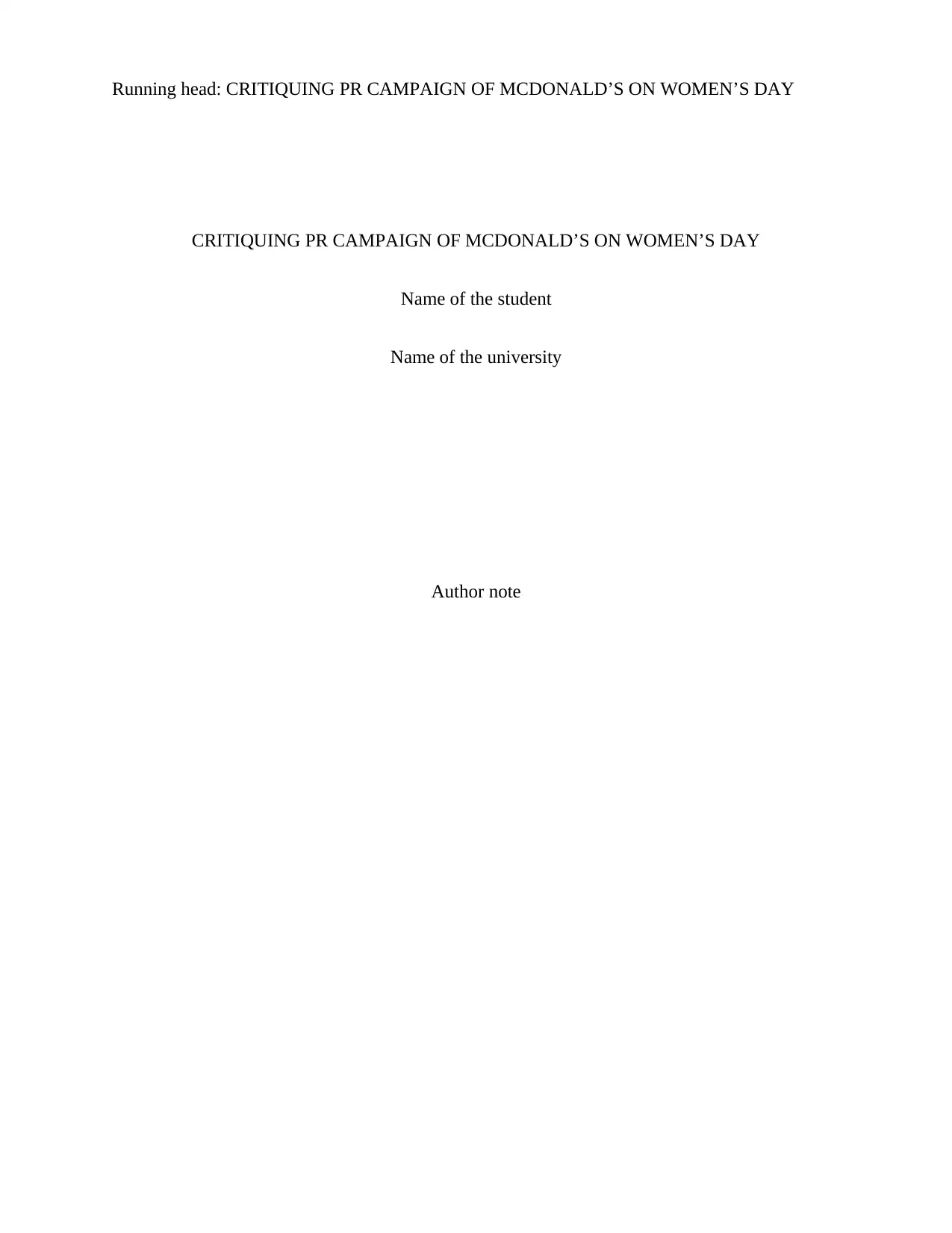
Running head: CRITIQUING PR CAMPAIGN OF MCDONALD’S ON WOMEN’S DAY
CRITIQUING PR CAMPAIGN OF MCDONALD’S ON WOMEN’S DAY
Name of the student
Name of the university
Author note
CRITIQUING PR CAMPAIGN OF MCDONALD’S ON WOMEN’S DAY
Name of the student
Name of the university
Author note
Paraphrase This Document
Need a fresh take? Get an instant paraphrase of this document with our AI Paraphraser
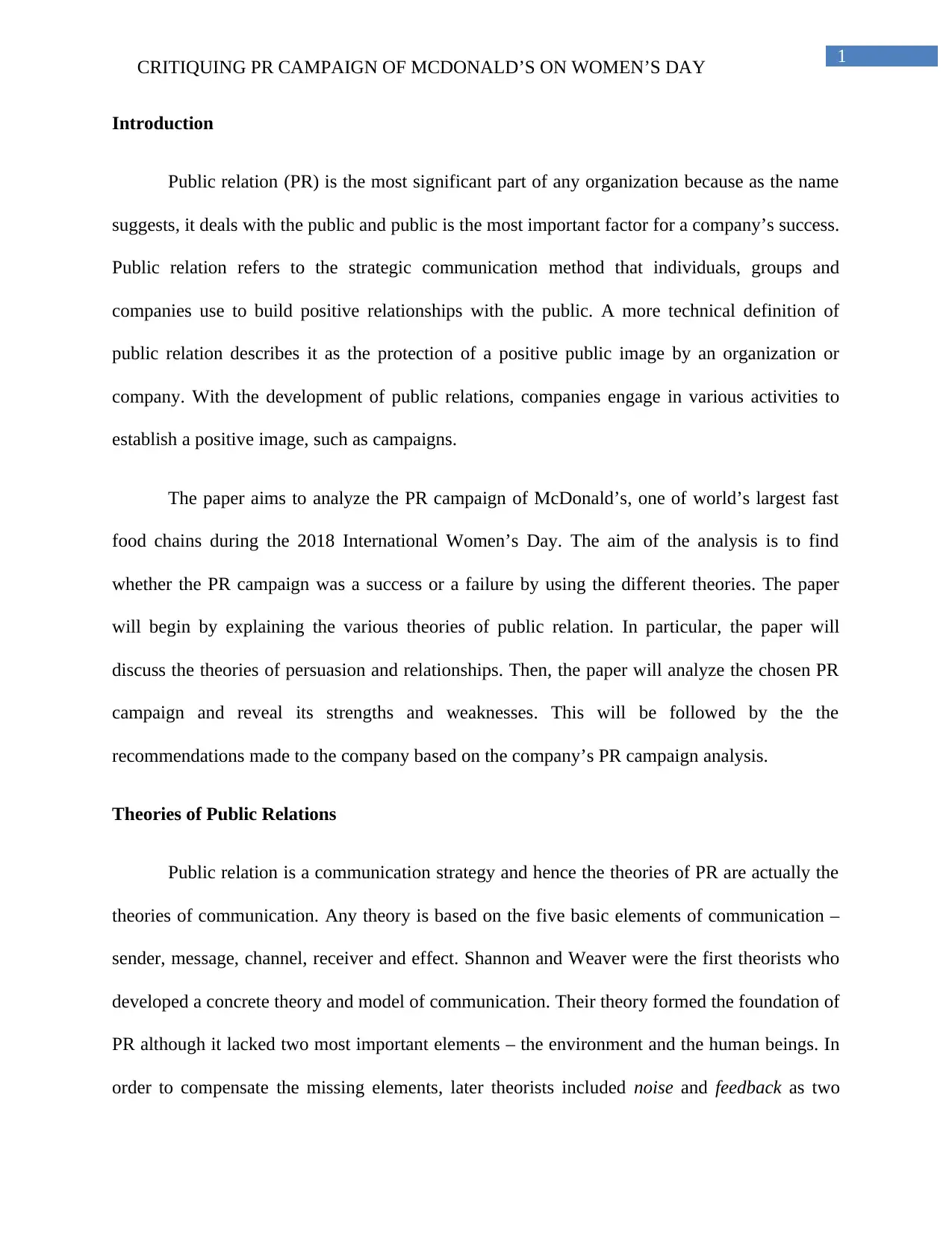
1
CRITIQUING PR CAMPAIGN OF MCDONALD’S ON WOMEN’S DAY
Introduction
Public relation (PR) is the most significant part of any organization because as the name
suggests, it deals with the public and public is the most important factor for a company’s success.
Public relation refers to the strategic communication method that individuals, groups and
companies use to build positive relationships with the public. A more technical definition of
public relation describes it as the protection of a positive public image by an organization or
company. With the development of public relations, companies engage in various activities to
establish a positive image, such as campaigns.
The paper aims to analyze the PR campaign of McDonald’s, one of world’s largest fast
food chains during the 2018 International Women’s Day. The aim of the analysis is to find
whether the PR campaign was a success or a failure by using the different theories. The paper
will begin by explaining the various theories of public relation. In particular, the paper will
discuss the theories of persuasion and relationships. Then, the paper will analyze the chosen PR
campaign and reveal its strengths and weaknesses. This will be followed by the the
recommendations made to the company based on the company’s PR campaign analysis.
Theories of Public Relations
Public relation is a communication strategy and hence the theories of PR are actually the
theories of communication. Any theory is based on the five basic elements of communication –
sender, message, channel, receiver and effect. Shannon and Weaver were the first theorists who
developed a concrete theory and model of communication. Their theory formed the foundation of
PR although it lacked two most important elements – the environment and the human beings. In
order to compensate the missing elements, later theorists included noise and feedback as two
CRITIQUING PR CAMPAIGN OF MCDONALD’S ON WOMEN’S DAY
Introduction
Public relation (PR) is the most significant part of any organization because as the name
suggests, it deals with the public and public is the most important factor for a company’s success.
Public relation refers to the strategic communication method that individuals, groups and
companies use to build positive relationships with the public. A more technical definition of
public relation describes it as the protection of a positive public image by an organization or
company. With the development of public relations, companies engage in various activities to
establish a positive image, such as campaigns.
The paper aims to analyze the PR campaign of McDonald’s, one of world’s largest fast
food chains during the 2018 International Women’s Day. The aim of the analysis is to find
whether the PR campaign was a success or a failure by using the different theories. The paper
will begin by explaining the various theories of public relation. In particular, the paper will
discuss the theories of persuasion and relationships. Then, the paper will analyze the chosen PR
campaign and reveal its strengths and weaknesses. This will be followed by the the
recommendations made to the company based on the company’s PR campaign analysis.
Theories of Public Relations
Public relation is a communication strategy and hence the theories of PR are actually the
theories of communication. Any theory is based on the five basic elements of communication –
sender, message, channel, receiver and effect. Shannon and Weaver were the first theorists who
developed a concrete theory and model of communication. Their theory formed the foundation of
PR although it lacked two most important elements – the environment and the human beings. In
order to compensate the missing elements, later theorists included noise and feedback as two
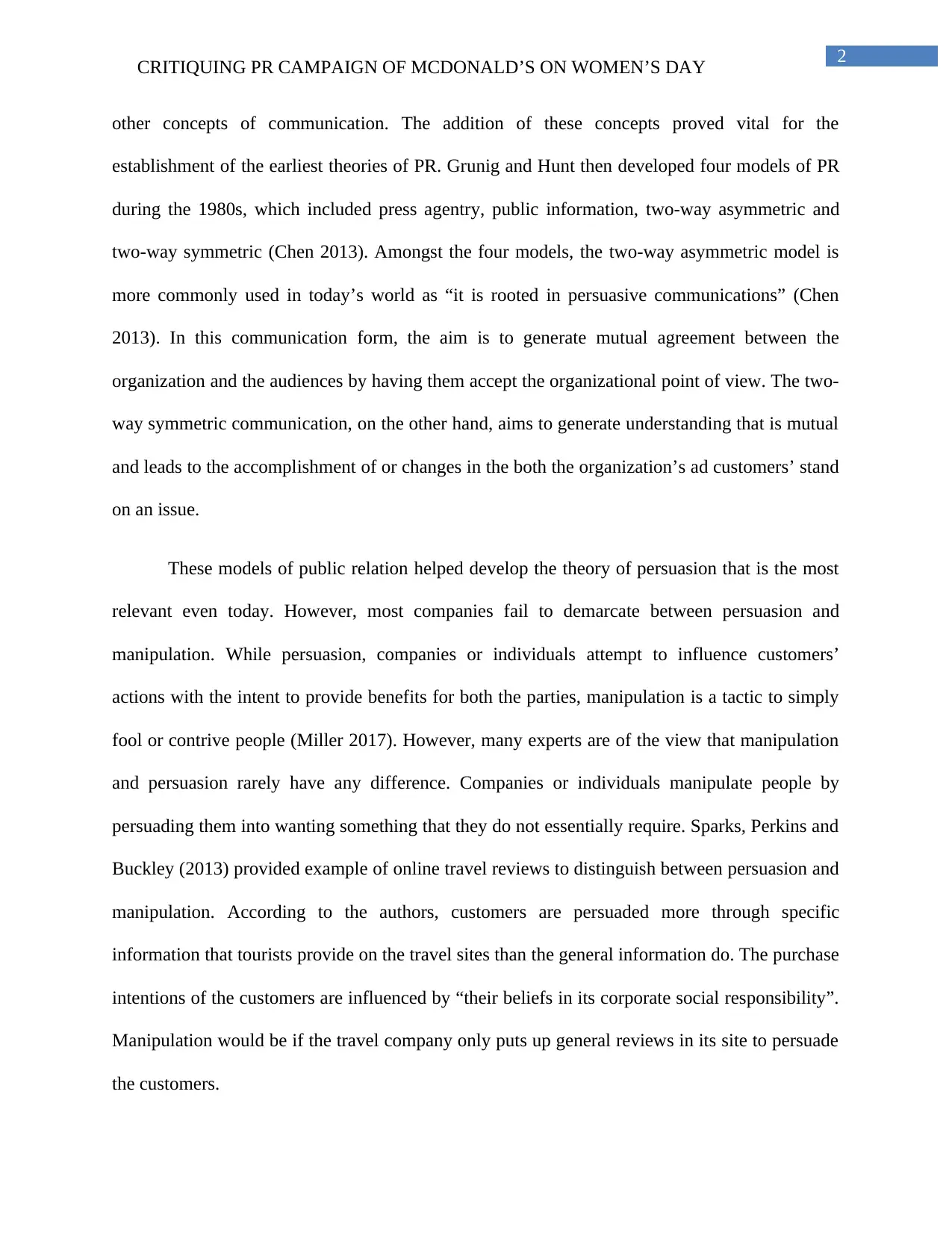
2
CRITIQUING PR CAMPAIGN OF MCDONALD’S ON WOMEN’S DAY
other concepts of communication. The addition of these concepts proved vital for the
establishment of the earliest theories of PR. Grunig and Hunt then developed four models of PR
during the 1980s, which included press agentry, public information, two-way asymmetric and
two-way symmetric (Chen 2013). Amongst the four models, the two-way asymmetric model is
more commonly used in today’s world as “it is rooted in persuasive communications” (Chen
2013). In this communication form, the aim is to generate mutual agreement between the
organization and the audiences by having them accept the organizational point of view. The two-
way symmetric communication, on the other hand, aims to generate understanding that is mutual
and leads to the accomplishment of or changes in the both the organization’s ad customers’ stand
on an issue.
These models of public relation helped develop the theory of persuasion that is the most
relevant even today. However, most companies fail to demarcate between persuasion and
manipulation. While persuasion, companies or individuals attempt to influence customers’
actions with the intent to provide benefits for both the parties, manipulation is a tactic to simply
fool or contrive people (Miller 2017). However, many experts are of the view that manipulation
and persuasion rarely have any difference. Companies or individuals manipulate people by
persuading them into wanting something that they do not essentially require. Sparks, Perkins and
Buckley (2013) provided example of online travel reviews to distinguish between persuasion and
manipulation. According to the authors, customers are persuaded more through specific
information that tourists provide on the travel sites than the general information do. The purchase
intentions of the customers are influenced by “their beliefs in its corporate social responsibility”.
Manipulation would be if the travel company only puts up general reviews in its site to persuade
the customers.
CRITIQUING PR CAMPAIGN OF MCDONALD’S ON WOMEN’S DAY
other concepts of communication. The addition of these concepts proved vital for the
establishment of the earliest theories of PR. Grunig and Hunt then developed four models of PR
during the 1980s, which included press agentry, public information, two-way asymmetric and
two-way symmetric (Chen 2013). Amongst the four models, the two-way asymmetric model is
more commonly used in today’s world as “it is rooted in persuasive communications” (Chen
2013). In this communication form, the aim is to generate mutual agreement between the
organization and the audiences by having them accept the organizational point of view. The two-
way symmetric communication, on the other hand, aims to generate understanding that is mutual
and leads to the accomplishment of or changes in the both the organization’s ad customers’ stand
on an issue.
These models of public relation helped develop the theory of persuasion that is the most
relevant even today. However, most companies fail to demarcate between persuasion and
manipulation. While persuasion, companies or individuals attempt to influence customers’
actions with the intent to provide benefits for both the parties, manipulation is a tactic to simply
fool or contrive people (Miller 2017). However, many experts are of the view that manipulation
and persuasion rarely have any difference. Companies or individuals manipulate people by
persuading them into wanting something that they do not essentially require. Sparks, Perkins and
Buckley (2013) provided example of online travel reviews to distinguish between persuasion and
manipulation. According to the authors, customers are persuaded more through specific
information that tourists provide on the travel sites than the general information do. The purchase
intentions of the customers are influenced by “their beliefs in its corporate social responsibility”.
Manipulation would be if the travel company only puts up general reviews in its site to persuade
the customers.
⊘ This is a preview!⊘
Do you want full access?
Subscribe today to unlock all pages.

Trusted by 1+ million students worldwide
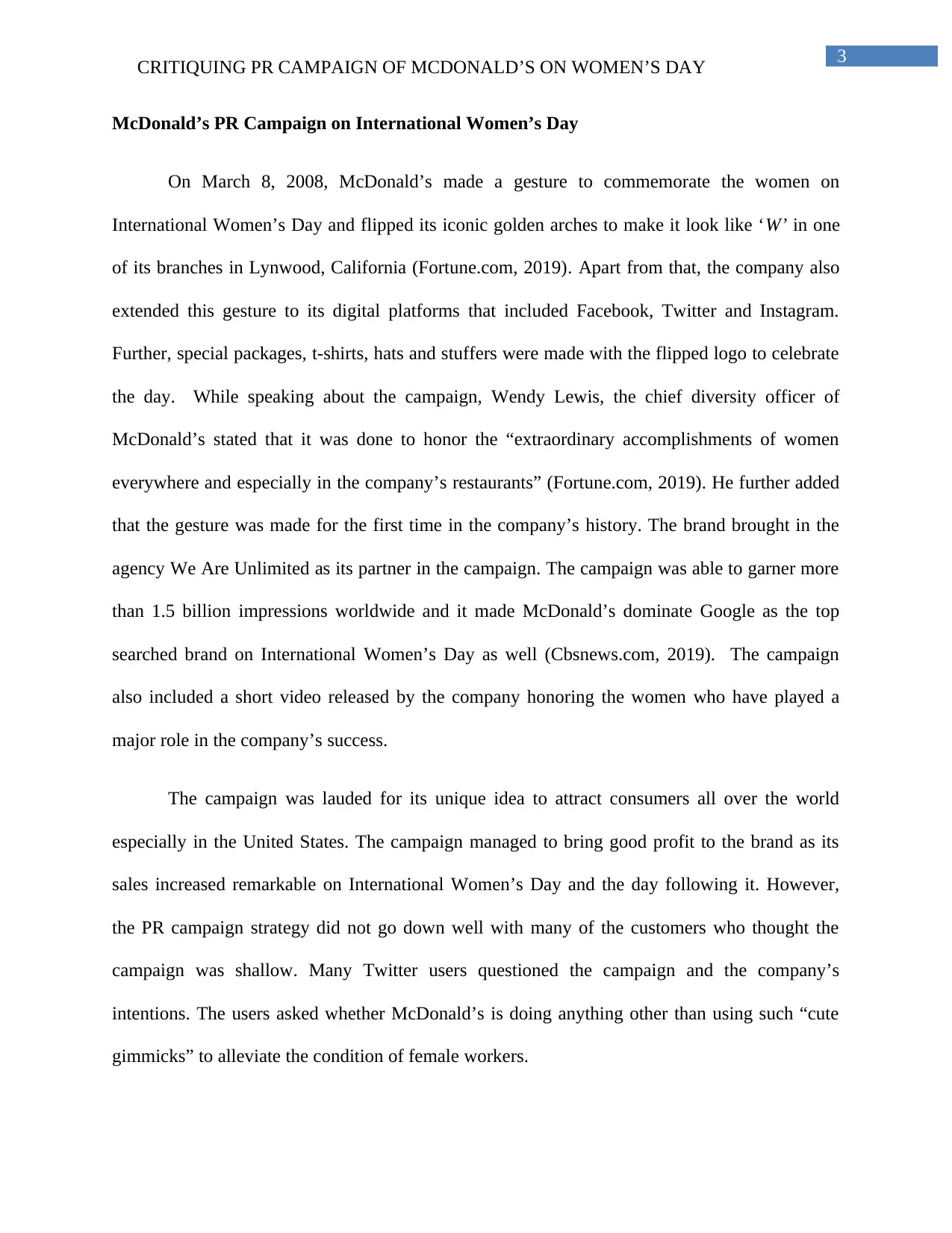
3
CRITIQUING PR CAMPAIGN OF MCDONALD’S ON WOMEN’S DAY
McDonald’s PR Campaign on International Women’s Day
On March 8, 2008, McDonald’s made a gesture to commemorate the women on
International Women’s Day and flipped its iconic golden arches to make it look like ‘W’ in one
of its branches in Lynwood, California (Fortune.com, 2019). Apart from that, the company also
extended this gesture to its digital platforms that included Facebook, Twitter and Instagram.
Further, special packages, t-shirts, hats and stuffers were made with the flipped logo to celebrate
the day. While speaking about the campaign, Wendy Lewis, the chief diversity officer of
McDonald’s stated that it was done to honor the “extraordinary accomplishments of women
everywhere and especially in the company’s restaurants” (Fortune.com, 2019). He further added
that the gesture was made for the first time in the company’s history. The brand brought in the
agency We Are Unlimited as its partner in the campaign. The campaign was able to garner more
than 1.5 billion impressions worldwide and it made McDonald’s dominate Google as the top
searched brand on International Women’s Day as well (Cbsnews.com, 2019). The campaign
also included a short video released by the company honoring the women who have played a
major role in the company’s success.
The campaign was lauded for its unique idea to attract consumers all over the world
especially in the United States. The campaign managed to bring good profit to the brand as its
sales increased remarkable on International Women’s Day and the day following it. However,
the PR campaign strategy did not go down well with many of the customers who thought the
campaign was shallow. Many Twitter users questioned the campaign and the company’s
intentions. The users asked whether McDonald’s is doing anything other than using such “cute
gimmicks” to alleviate the condition of female workers.
CRITIQUING PR CAMPAIGN OF MCDONALD’S ON WOMEN’S DAY
McDonald’s PR Campaign on International Women’s Day
On March 8, 2008, McDonald’s made a gesture to commemorate the women on
International Women’s Day and flipped its iconic golden arches to make it look like ‘W’ in one
of its branches in Lynwood, California (Fortune.com, 2019). Apart from that, the company also
extended this gesture to its digital platforms that included Facebook, Twitter and Instagram.
Further, special packages, t-shirts, hats and stuffers were made with the flipped logo to celebrate
the day. While speaking about the campaign, Wendy Lewis, the chief diversity officer of
McDonald’s stated that it was done to honor the “extraordinary accomplishments of women
everywhere and especially in the company’s restaurants” (Fortune.com, 2019). He further added
that the gesture was made for the first time in the company’s history. The brand brought in the
agency We Are Unlimited as its partner in the campaign. The campaign was able to garner more
than 1.5 billion impressions worldwide and it made McDonald’s dominate Google as the top
searched brand on International Women’s Day as well (Cbsnews.com, 2019). The campaign
also included a short video released by the company honoring the women who have played a
major role in the company’s success.
The campaign was lauded for its unique idea to attract consumers all over the world
especially in the United States. The campaign managed to bring good profit to the brand as its
sales increased remarkable on International Women’s Day and the day following it. However,
the PR campaign strategy did not go down well with many of the customers who thought the
campaign was shallow. Many Twitter users questioned the campaign and the company’s
intentions. The users asked whether McDonald’s is doing anything other than using such “cute
gimmicks” to alleviate the condition of female workers.
Paraphrase This Document
Need a fresh take? Get an instant paraphrase of this document with our AI Paraphraser
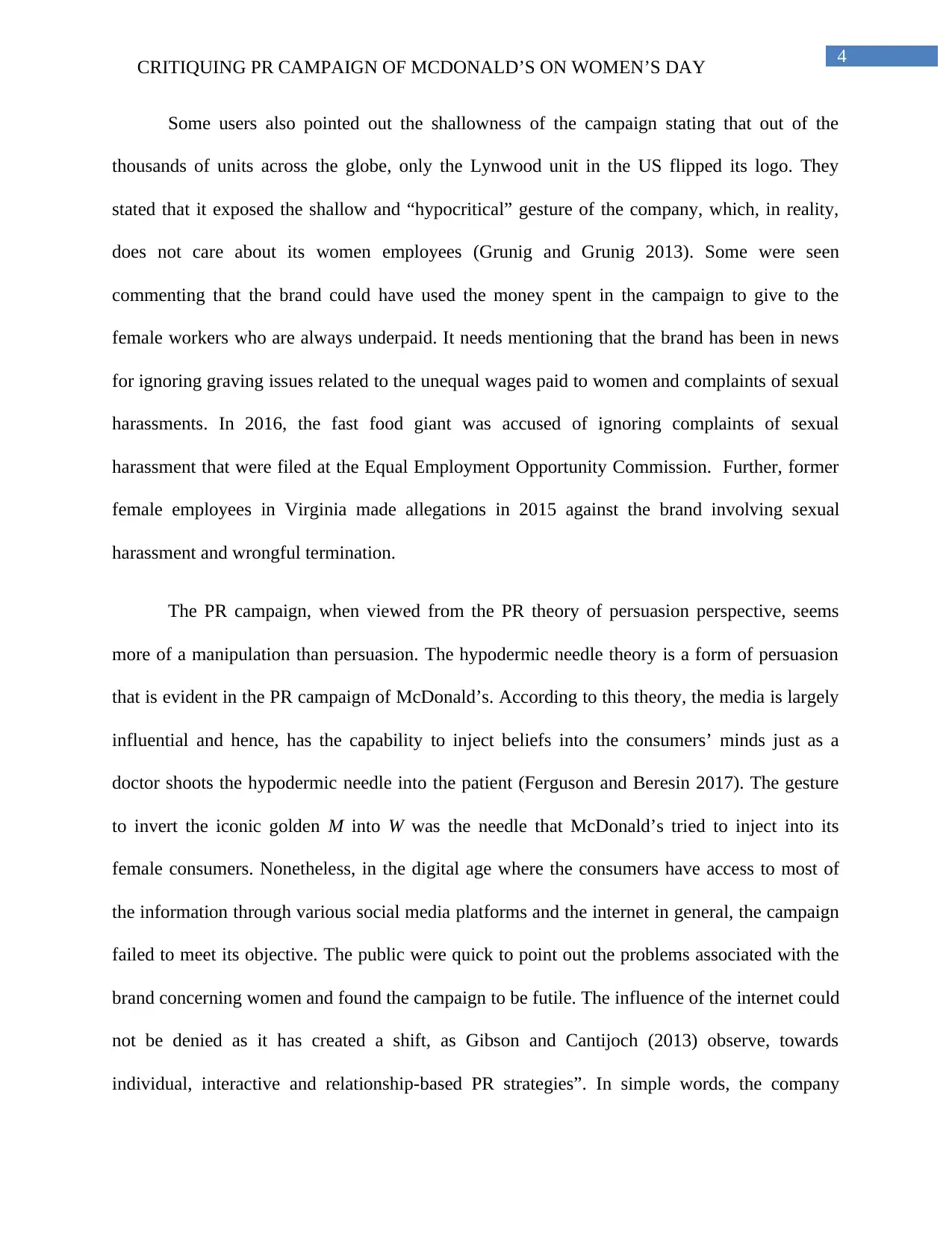
4
CRITIQUING PR CAMPAIGN OF MCDONALD’S ON WOMEN’S DAY
Some users also pointed out the shallowness of the campaign stating that out of the
thousands of units across the globe, only the Lynwood unit in the US flipped its logo. They
stated that it exposed the shallow and “hypocritical” gesture of the company, which, in reality,
does not care about its women employees (Grunig and Grunig 2013). Some were seen
commenting that the brand could have used the money spent in the campaign to give to the
female workers who are always underpaid. It needs mentioning that the brand has been in news
for ignoring graving issues related to the unequal wages paid to women and complaints of sexual
harassments. In 2016, the fast food giant was accused of ignoring complaints of sexual
harassment that were filed at the Equal Employment Opportunity Commission. Further, former
female employees in Virginia made allegations in 2015 against the brand involving sexual
harassment and wrongful termination.
The PR campaign, when viewed from the PR theory of persuasion perspective, seems
more of a manipulation than persuasion. The hypodermic needle theory is a form of persuasion
that is evident in the PR campaign of McDonald’s. According to this theory, the media is largely
influential and hence, has the capability to inject beliefs into the consumers’ minds just as a
doctor shoots the hypodermic needle into the patient (Ferguson and Beresin 2017). The gesture
to invert the iconic golden M into W was the needle that McDonald’s tried to inject into its
female consumers. Nonetheless, in the digital age where the consumers have access to most of
the information through various social media platforms and the internet in general, the campaign
failed to meet its objective. The public were quick to point out the problems associated with the
brand concerning women and found the campaign to be futile. The influence of the internet could
not be denied as it has created a shift, as Gibson and Cantijoch (2013) observe, towards
individual, interactive and relationship-based PR strategies”. In simple words, the company
CRITIQUING PR CAMPAIGN OF MCDONALD’S ON WOMEN’S DAY
Some users also pointed out the shallowness of the campaign stating that out of the
thousands of units across the globe, only the Lynwood unit in the US flipped its logo. They
stated that it exposed the shallow and “hypocritical” gesture of the company, which, in reality,
does not care about its women employees (Grunig and Grunig 2013). Some were seen
commenting that the brand could have used the money spent in the campaign to give to the
female workers who are always underpaid. It needs mentioning that the brand has been in news
for ignoring graving issues related to the unequal wages paid to women and complaints of sexual
harassments. In 2016, the fast food giant was accused of ignoring complaints of sexual
harassment that were filed at the Equal Employment Opportunity Commission. Further, former
female employees in Virginia made allegations in 2015 against the brand involving sexual
harassment and wrongful termination.
The PR campaign, when viewed from the PR theory of persuasion perspective, seems
more of a manipulation than persuasion. The hypodermic needle theory is a form of persuasion
that is evident in the PR campaign of McDonald’s. According to this theory, the media is largely
influential and hence, has the capability to inject beliefs into the consumers’ minds just as a
doctor shoots the hypodermic needle into the patient (Ferguson and Beresin 2017). The gesture
to invert the iconic golden M into W was the needle that McDonald’s tried to inject into its
female consumers. Nonetheless, in the digital age where the consumers have access to most of
the information through various social media platforms and the internet in general, the campaign
failed to meet its objective. The public were quick to point out the problems associated with the
brand concerning women and found the campaign to be futile. The influence of the internet could
not be denied as it has created a shift, as Gibson and Cantijoch (2013) observe, towards
individual, interactive and relationship-based PR strategies”. In simple words, the company
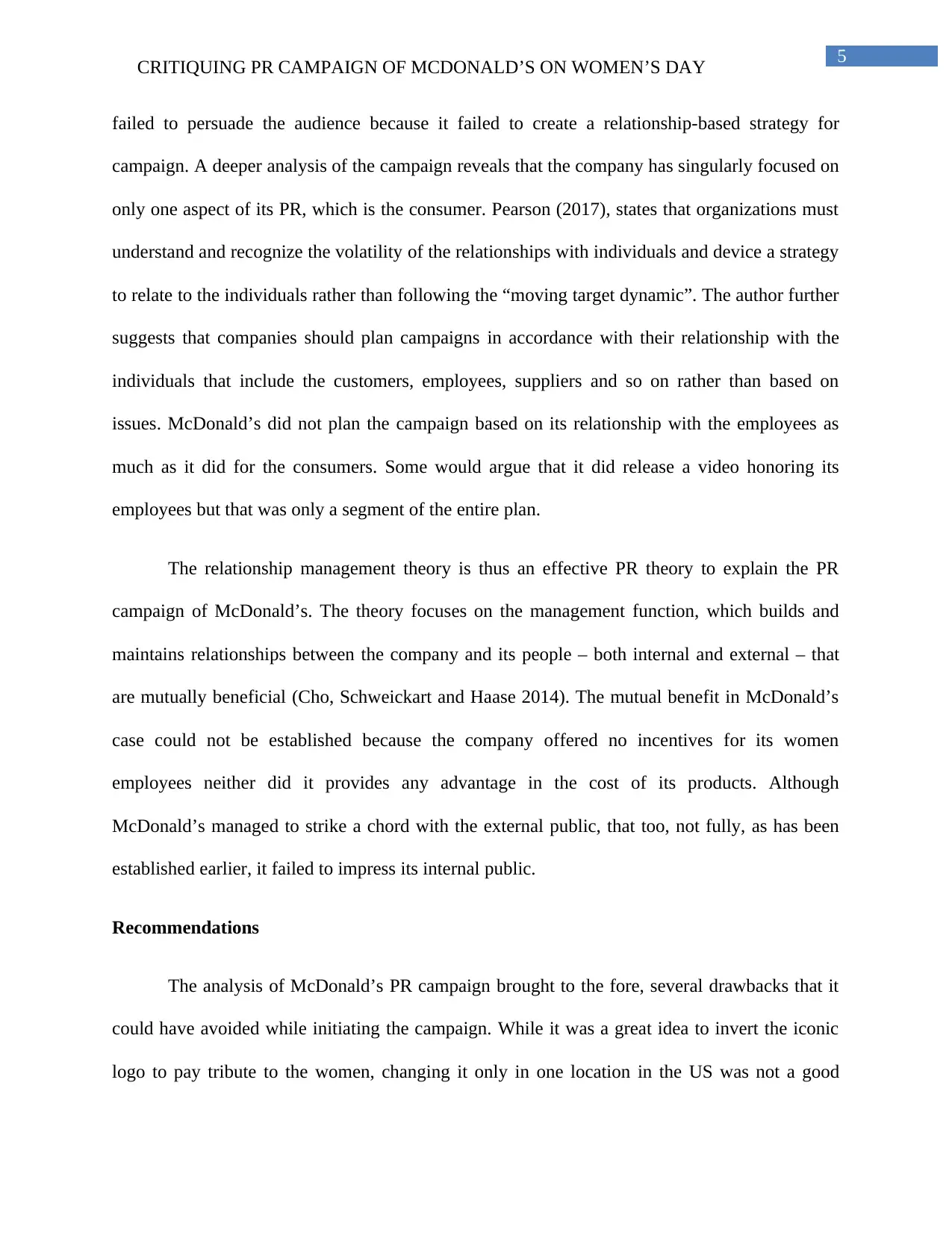
5
CRITIQUING PR CAMPAIGN OF MCDONALD’S ON WOMEN’S DAY
failed to persuade the audience because it failed to create a relationship-based strategy for
campaign. A deeper analysis of the campaign reveals that the company has singularly focused on
only one aspect of its PR, which is the consumer. Pearson (2017), states that organizations must
understand and recognize the volatility of the relationships with individuals and device a strategy
to relate to the individuals rather than following the “moving target dynamic”. The author further
suggests that companies should plan campaigns in accordance with their relationship with the
individuals that include the customers, employees, suppliers and so on rather than based on
issues. McDonald’s did not plan the campaign based on its relationship with the employees as
much as it did for the consumers. Some would argue that it did release a video honoring its
employees but that was only a segment of the entire plan.
The relationship management theory is thus an effective PR theory to explain the PR
campaign of McDonald’s. The theory focuses on the management function, which builds and
maintains relationships between the company and its people – both internal and external – that
are mutually beneficial (Cho, Schweickart and Haase 2014). The mutual benefit in McDonald’s
case could not be established because the company offered no incentives for its women
employees neither did it provides any advantage in the cost of its products. Although
McDonald’s managed to strike a chord with the external public, that too, not fully, as has been
established earlier, it failed to impress its internal public.
Recommendations
The analysis of McDonald’s PR campaign brought to the fore, several drawbacks that it
could have avoided while initiating the campaign. While it was a great idea to invert the iconic
logo to pay tribute to the women, changing it only in one location in the US was not a good
CRITIQUING PR CAMPAIGN OF MCDONALD’S ON WOMEN’S DAY
failed to persuade the audience because it failed to create a relationship-based strategy for
campaign. A deeper analysis of the campaign reveals that the company has singularly focused on
only one aspect of its PR, which is the consumer. Pearson (2017), states that organizations must
understand and recognize the volatility of the relationships with individuals and device a strategy
to relate to the individuals rather than following the “moving target dynamic”. The author further
suggests that companies should plan campaigns in accordance with their relationship with the
individuals that include the customers, employees, suppliers and so on rather than based on
issues. McDonald’s did not plan the campaign based on its relationship with the employees as
much as it did for the consumers. Some would argue that it did release a video honoring its
employees but that was only a segment of the entire plan.
The relationship management theory is thus an effective PR theory to explain the PR
campaign of McDonald’s. The theory focuses on the management function, which builds and
maintains relationships between the company and its people – both internal and external – that
are mutually beneficial (Cho, Schweickart and Haase 2014). The mutual benefit in McDonald’s
case could not be established because the company offered no incentives for its women
employees neither did it provides any advantage in the cost of its products. Although
McDonald’s managed to strike a chord with the external public, that too, not fully, as has been
established earlier, it failed to impress its internal public.
Recommendations
The analysis of McDonald’s PR campaign brought to the fore, several drawbacks that it
could have avoided while initiating the campaign. While it was a great idea to invert the iconic
logo to pay tribute to the women, changing it only in one location in the US was not a good
⊘ This is a preview!⊘
Do you want full access?
Subscribe today to unlock all pages.

Trusted by 1+ million students worldwide
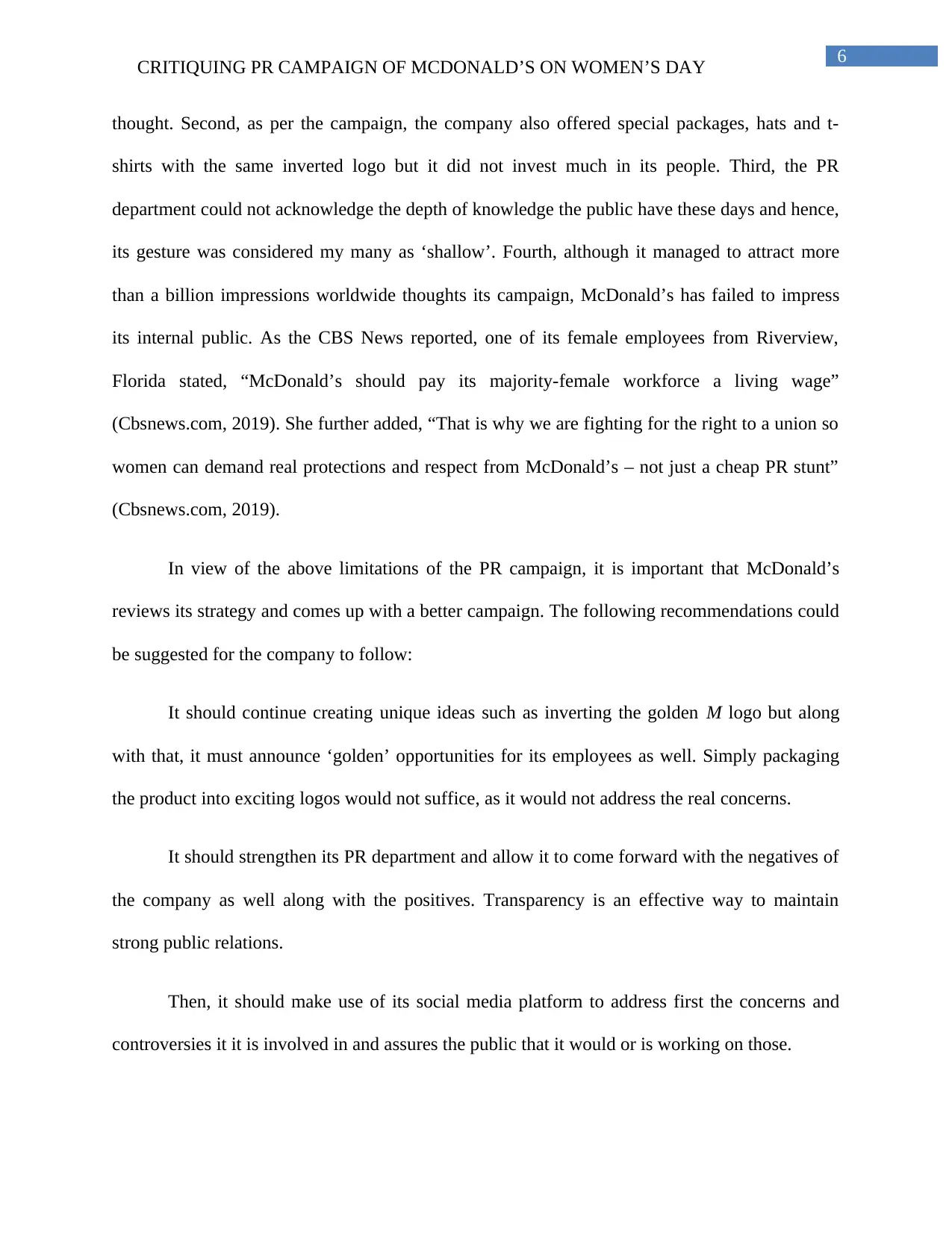
6
CRITIQUING PR CAMPAIGN OF MCDONALD’S ON WOMEN’S DAY
thought. Second, as per the campaign, the company also offered special packages, hats and t-
shirts with the same inverted logo but it did not invest much in its people. Third, the PR
department could not acknowledge the depth of knowledge the public have these days and hence,
its gesture was considered my many as ‘shallow’. Fourth, although it managed to attract more
than a billion impressions worldwide thoughts its campaign, McDonald’s has failed to impress
its internal public. As the CBS News reported, one of its female employees from Riverview,
Florida stated, “McDonald’s should pay its majority-female workforce a living wage”
(Cbsnews.com, 2019). She further added, “That is why we are fighting for the right to a union so
women can demand real protections and respect from McDonald’s – not just a cheap PR stunt”
(Cbsnews.com, 2019).
In view of the above limitations of the PR campaign, it is important that McDonald’s
reviews its strategy and comes up with a better campaign. The following recommendations could
be suggested for the company to follow:
It should continue creating unique ideas such as inverting the golden M logo but along
with that, it must announce ‘golden’ opportunities for its employees as well. Simply packaging
the product into exciting logos would not suffice, as it would not address the real concerns.
It should strengthen its PR department and allow it to come forward with the negatives of
the company as well along with the positives. Transparency is an effective way to maintain
strong public relations.
Then, it should make use of its social media platform to address first the concerns and
controversies it it is involved in and assures the public that it would or is working on those.
CRITIQUING PR CAMPAIGN OF MCDONALD’S ON WOMEN’S DAY
thought. Second, as per the campaign, the company also offered special packages, hats and t-
shirts with the same inverted logo but it did not invest much in its people. Third, the PR
department could not acknowledge the depth of knowledge the public have these days and hence,
its gesture was considered my many as ‘shallow’. Fourth, although it managed to attract more
than a billion impressions worldwide thoughts its campaign, McDonald’s has failed to impress
its internal public. As the CBS News reported, one of its female employees from Riverview,
Florida stated, “McDonald’s should pay its majority-female workforce a living wage”
(Cbsnews.com, 2019). She further added, “That is why we are fighting for the right to a union so
women can demand real protections and respect from McDonald’s – not just a cheap PR stunt”
(Cbsnews.com, 2019).
In view of the above limitations of the PR campaign, it is important that McDonald’s
reviews its strategy and comes up with a better campaign. The following recommendations could
be suggested for the company to follow:
It should continue creating unique ideas such as inverting the golden M logo but along
with that, it must announce ‘golden’ opportunities for its employees as well. Simply packaging
the product into exciting logos would not suffice, as it would not address the real concerns.
It should strengthen its PR department and allow it to come forward with the negatives of
the company as well along with the positives. Transparency is an effective way to maintain
strong public relations.
Then, it should make use of its social media platform to address first the concerns and
controversies it it is involved in and assures the public that it would or is working on those.
Paraphrase This Document
Need a fresh take? Get an instant paraphrase of this document with our AI Paraphraser
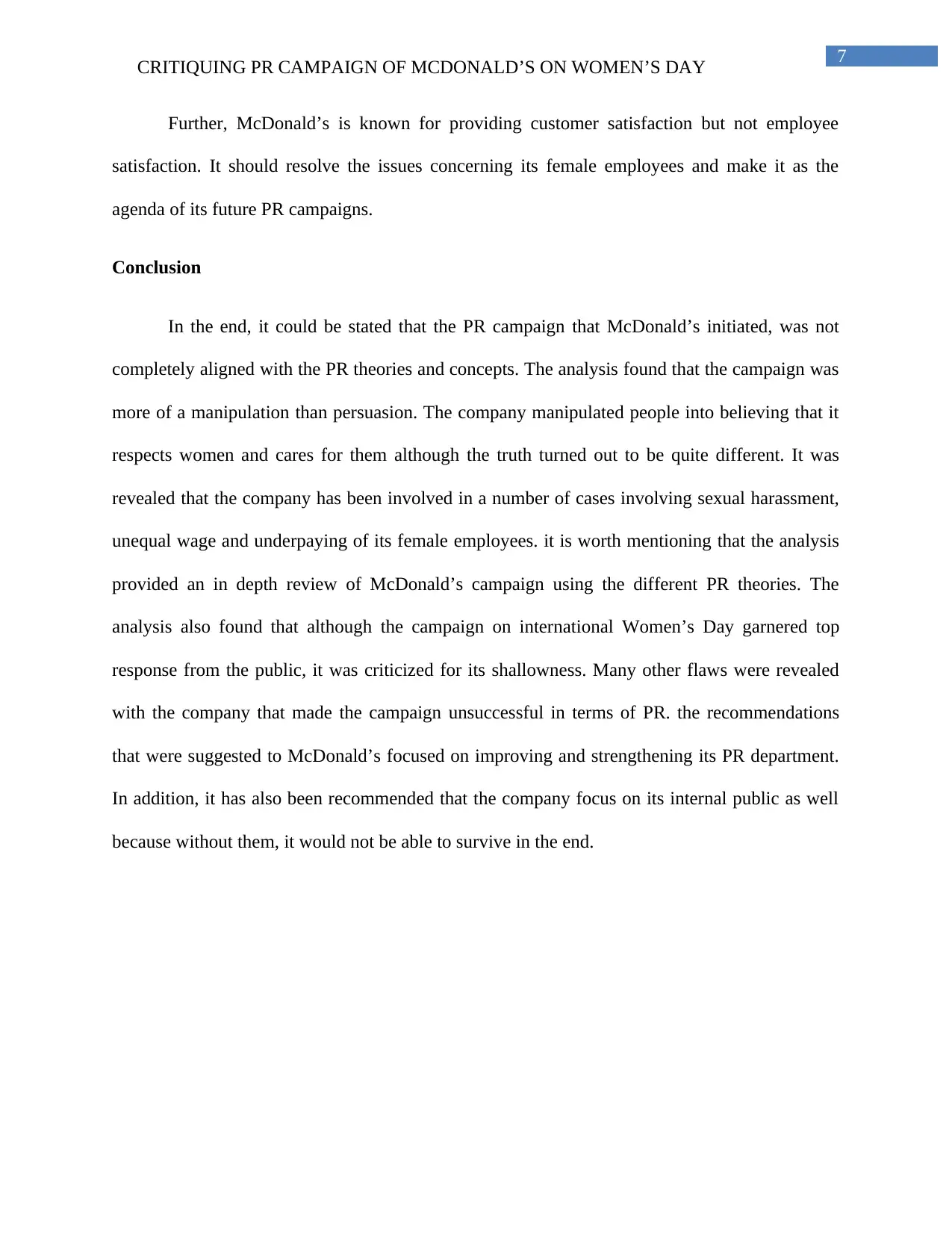
7
CRITIQUING PR CAMPAIGN OF MCDONALD’S ON WOMEN’S DAY
Further, McDonald’s is known for providing customer satisfaction but not employee
satisfaction. It should resolve the issues concerning its female employees and make it as the
agenda of its future PR campaigns.
Conclusion
In the end, it could be stated that the PR campaign that McDonald’s initiated, was not
completely aligned with the PR theories and concepts. The analysis found that the campaign was
more of a manipulation than persuasion. The company manipulated people into believing that it
respects women and cares for them although the truth turned out to be quite different. It was
revealed that the company has been involved in a number of cases involving sexual harassment,
unequal wage and underpaying of its female employees. it is worth mentioning that the analysis
provided an in depth review of McDonald’s campaign using the different PR theories. The
analysis also found that although the campaign on international Women’s Day garnered top
response from the public, it was criticized for its shallowness. Many other flaws were revealed
with the company that made the campaign unsuccessful in terms of PR. the recommendations
that were suggested to McDonald’s focused on improving and strengthening its PR department.
In addition, it has also been recommended that the company focus on its internal public as well
because without them, it would not be able to survive in the end.
CRITIQUING PR CAMPAIGN OF MCDONALD’S ON WOMEN’S DAY
Further, McDonald’s is known for providing customer satisfaction but not employee
satisfaction. It should resolve the issues concerning its female employees and make it as the
agenda of its future PR campaigns.
Conclusion
In the end, it could be stated that the PR campaign that McDonald’s initiated, was not
completely aligned with the PR theories and concepts. The analysis found that the campaign was
more of a manipulation than persuasion. The company manipulated people into believing that it
respects women and cares for them although the truth turned out to be quite different. It was
revealed that the company has been involved in a number of cases involving sexual harassment,
unequal wage and underpaying of its female employees. it is worth mentioning that the analysis
provided an in depth review of McDonald’s campaign using the different PR theories. The
analysis also found that although the campaign on international Women’s Day garnered top
response from the public, it was criticized for its shallowness. Many other flaws were revealed
with the company that made the campaign unsuccessful in terms of PR. the recommendations
that were suggested to McDonald’s focused on improving and strengthening its PR department.
In addition, it has also been recommended that the company focus on its internal public as well
because without them, it would not be able to survive in the end.
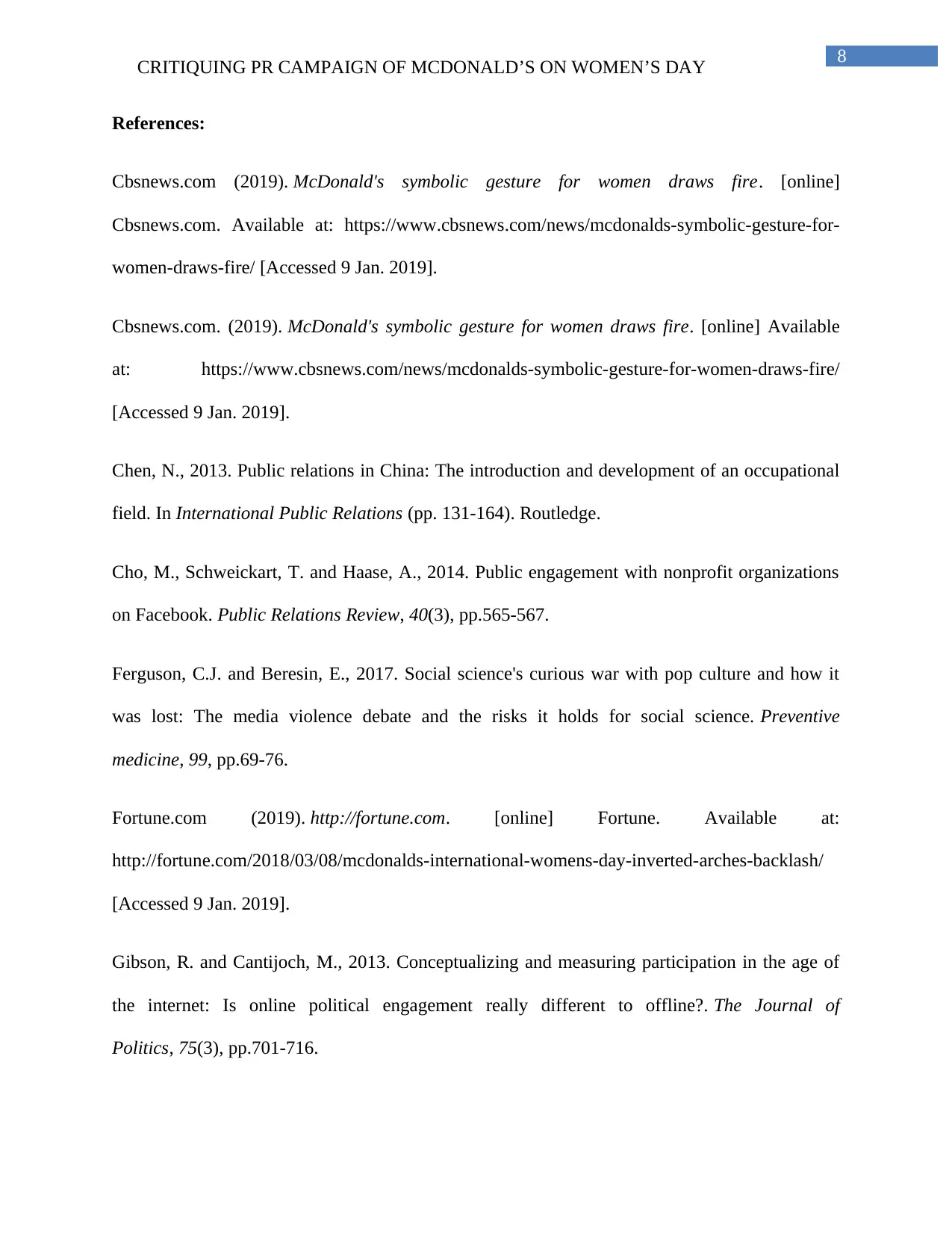
8
CRITIQUING PR CAMPAIGN OF MCDONALD’S ON WOMEN’S DAY
References:
Cbsnews.com (2019). McDonald's symbolic gesture for women draws fire. [online]
Cbsnews.com. Available at: https://www.cbsnews.com/news/mcdonalds-symbolic-gesture-for-
women-draws-fire/ [Accessed 9 Jan. 2019].
Cbsnews.com. (2019). McDonald's symbolic gesture for women draws fire. [online] Available
at: https://www.cbsnews.com/news/mcdonalds-symbolic-gesture-for-women-draws-fire/
[Accessed 9 Jan. 2019].
Chen, N., 2013. Public relations in China: The introduction and development of an occupational
field. In International Public Relations (pp. 131-164). Routledge.
Cho, M., Schweickart, T. and Haase, A., 2014. Public engagement with nonprofit organizations
on Facebook. Public Relations Review, 40(3), pp.565-567.
Ferguson, C.J. and Beresin, E., 2017. Social science's curious war with pop culture and how it
was lost: The media violence debate and the risks it holds for social science. Preventive
medicine, 99, pp.69-76.
Fortune.com (2019). http://fortune.com. [online] Fortune. Available at:
http://fortune.com/2018/03/08/mcdonalds-international-womens-day-inverted-arches-backlash/
[Accessed 9 Jan. 2019].
Gibson, R. and Cantijoch, M., 2013. Conceptualizing and measuring participation in the age of
the internet: Is online political engagement really different to offline?. The Journal of
Politics, 75(3), pp.701-716.
CRITIQUING PR CAMPAIGN OF MCDONALD’S ON WOMEN’S DAY
References:
Cbsnews.com (2019). McDonald's symbolic gesture for women draws fire. [online]
Cbsnews.com. Available at: https://www.cbsnews.com/news/mcdonalds-symbolic-gesture-for-
women-draws-fire/ [Accessed 9 Jan. 2019].
Cbsnews.com. (2019). McDonald's symbolic gesture for women draws fire. [online] Available
at: https://www.cbsnews.com/news/mcdonalds-symbolic-gesture-for-women-draws-fire/
[Accessed 9 Jan. 2019].
Chen, N., 2013. Public relations in China: The introduction and development of an occupational
field. In International Public Relations (pp. 131-164). Routledge.
Cho, M., Schweickart, T. and Haase, A., 2014. Public engagement with nonprofit organizations
on Facebook. Public Relations Review, 40(3), pp.565-567.
Ferguson, C.J. and Beresin, E., 2017. Social science's curious war with pop culture and how it
was lost: The media violence debate and the risks it holds for social science. Preventive
medicine, 99, pp.69-76.
Fortune.com (2019). http://fortune.com. [online] Fortune. Available at:
http://fortune.com/2018/03/08/mcdonalds-international-womens-day-inverted-arches-backlash/
[Accessed 9 Jan. 2019].
Gibson, R. and Cantijoch, M., 2013. Conceptualizing and measuring participation in the age of
the internet: Is online political engagement really different to offline?. The Journal of
Politics, 75(3), pp.701-716.
⊘ This is a preview!⊘
Do you want full access?
Subscribe today to unlock all pages.

Trusted by 1+ million students worldwide
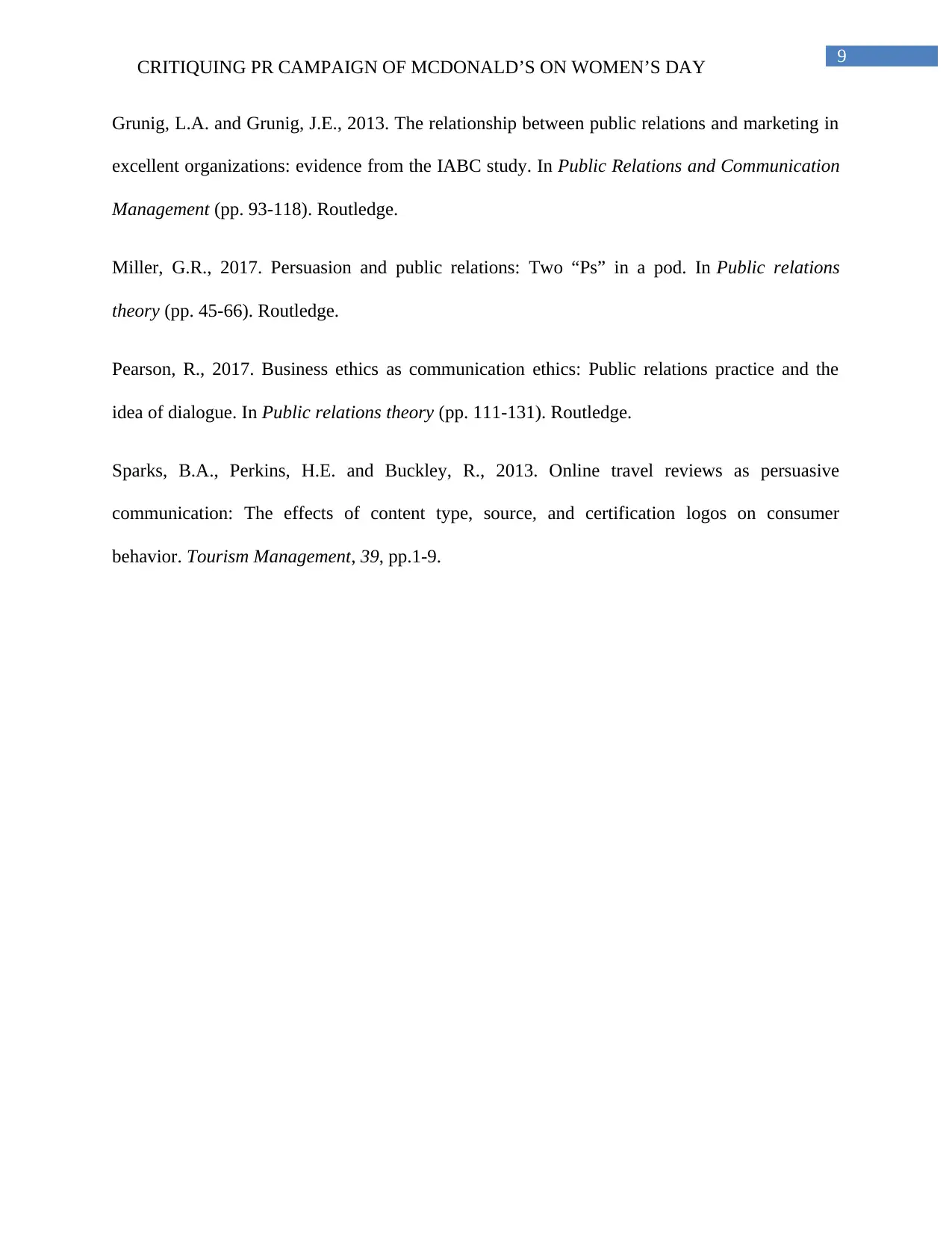
9
CRITIQUING PR CAMPAIGN OF MCDONALD’S ON WOMEN’S DAY
Grunig, L.A. and Grunig, J.E., 2013. The relationship between public relations and marketing in
excellent organizations: evidence from the IABC study. In Public Relations and Communication
Management (pp. 93-118). Routledge.
Miller, G.R., 2017. Persuasion and public relations: Two “Ps” in a pod. In Public relations
theory (pp. 45-66). Routledge.
Pearson, R., 2017. Business ethics as communication ethics: Public relations practice and the
idea of dialogue. In Public relations theory (pp. 111-131). Routledge.
Sparks, B.A., Perkins, H.E. and Buckley, R., 2013. Online travel reviews as persuasive
communication: The effects of content type, source, and certification logos on consumer
behavior. Tourism Management, 39, pp.1-9.
CRITIQUING PR CAMPAIGN OF MCDONALD’S ON WOMEN’S DAY
Grunig, L.A. and Grunig, J.E., 2013. The relationship between public relations and marketing in
excellent organizations: evidence from the IABC study. In Public Relations and Communication
Management (pp. 93-118). Routledge.
Miller, G.R., 2017. Persuasion and public relations: Two “Ps” in a pod. In Public relations
theory (pp. 45-66). Routledge.
Pearson, R., 2017. Business ethics as communication ethics: Public relations practice and the
idea of dialogue. In Public relations theory (pp. 111-131). Routledge.
Sparks, B.A., Perkins, H.E. and Buckley, R., 2013. Online travel reviews as persuasive
communication: The effects of content type, source, and certification logos on consumer
behavior. Tourism Management, 39, pp.1-9.
1 out of 10
Related Documents
Your All-in-One AI-Powered Toolkit for Academic Success.
+13062052269
info@desklib.com
Available 24*7 on WhatsApp / Email
![[object Object]](/_next/static/media/star-bottom.7253800d.svg)
Unlock your academic potential
Copyright © 2020–2025 A2Z Services. All Rights Reserved. Developed and managed by ZUCOL.





